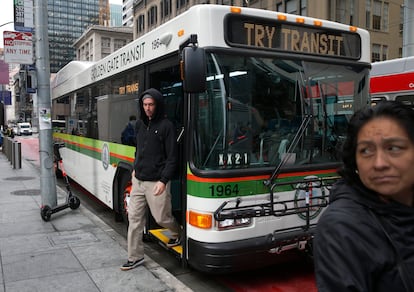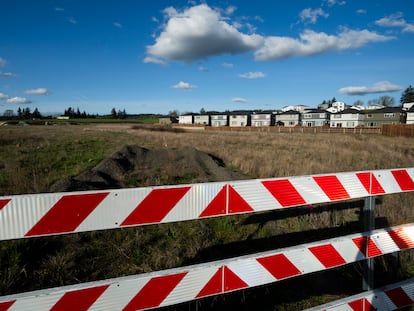To make housing more affordable and accessible, start with better bus systems
The U.S. government recently committed $18 million in 16 states to help communities plan for housing and neighborhoods built around public transit. But that’s just a drop in the bucket — much more commitment and funding is needed

We all know sitting in traffic is an enormous waste of our time and money. In fact, average Americans spend more than an hour each day behind the wheel, totaling nearly 93 billion hours spent driving in a year. All of this time in the car takes a serious toll on our mental and physical health. It’s also well known that tailpipe pollution results in harmful smog that can cause major health issues like asthma and lung disease, not to mention the 4.6 tons of planet-heating gasses that a single car emits annually. Therefore, it’s no surprise that the increasingly severe weather the U.S. has seen this year can be attributed, in part, to the impacts of our fuel-burning cars.
What is often less obvious, but just as troubling, is how the past century of car- and highway-centered development has contributed to our current housing and inequality crisis. Urban sprawl has forced those with the least resources to live further from jobs and services, adding to both our traffic and housing problems. Only 15% of homes were deemed affordable to the average household in 2023. Meanwhile, car ownership can add upwards of $10,000 to a family’s cost of living; at the same time, many low-income people without a car can be significantly limited in job options.
How did we arrive at a point where so many of us spend hours sitting in cars, draining time and money and taking a toll on our health and the environment? The U.S. has a long history of underinvesting in its cities and public services, resulting in rampant urban and suburban sprawl and few transport options beyond costly personal vehicles. This legacy is further rooted in racial inequities that continue to worsen air pollution and neighborhood division, particularly in communities of color.
While there’s no silver bullet to solving these deep-rooted issues, we need to start with re-imagining our relationship to transportation. The U.S. should commit to better transit systems that are easy-to-implement, cost-effective, and supportive of the kind of neighborhoods where housing is accessible to all. As the collapsing model of suburban development has shown us, a future that is more inclusive and sustainable is built on reshaping our cities into ones that are much more walkable, bikeable, and transit-friendly.
Our bus systems are one of the most essential but neglected pieces of public transit infrastructure in cities. Bus rapid transit (BRT), a type of system which operates like a metro at ground-level using buses, can carry more people faster and more reliably than cars and even conventional buses. BRT has been expanding in many places in the U.S. and certainly demands much greater attention.
Relative to other types of transit like metro rail, BRT can carry roughly the same amount of people per vehicle at significantly lower costs to build and operate. Compared to cars, BRT systems can shuttle tens of thousands of passengers an hour using the same amount of road space that would only move a few hundred if people travel by private vehicle. The fundamental features of BRT provide a bigger blueprint for improving all public transit by using elements like dedicated lanes, level-boarding for accessibility, and off-board fare collection to make services faster and simpler.
As the concept of BRT becomes more familiar, some U.S. cities are even emerging as BRT leaders. From the country’s first system in Pittsburgh (whose success has propelled more recent investments) to San Francisco’s 2022 debut of its Van Ness corridor, there is growing BRT enthusiasm amongst transit agencies and everyday riders. It can and should be recognized as one of the most cost-effective, quick-to-implement pieces of transit infrastructure that can help improve air quality, create jobs, and get people where they’re going quickly and affordably.
However, our transit systems can only help with the housing crisis if they are also embedded in urban planning strategies that emphasize denser, safer, cleaner, and greener neighborhoods. This type of development takes the focus off of cars and sprawl in favor of housing, jobs, and services that are accessible primarily by foot, bike, or public vehicles. Denser, transit-focused cities make housing inclusive and affordable for more average households — one study found that residents in transit-oriented neighborhoods can save upwards of $1,232 per year compared to owning a car. To address our housing problems at-scale, cities need to ensure transit is well-integrated with walking and cycling networks and that regulations, like income-based housing policies, prioritize affordability and diversity.
The U.S. government even recently committed $18 million in 16 states to help communities plan for housing and neighborhoods built around public transit. But that’s just a drop in the bucket — much more commitment and funding is needed to leverage the momentum of BRT and to ensure high-quality service. For example, city agencies planning for BRT need to address the key concerns impacting ridership, like overcrowding and public safety. Cities with established systems must invest in improving operations and maintaining users. Long-term planning is crucial to ensuring that BRT helps spur economic growth and smarter housing and commercial development.
Leaders must also make changes to address the bureaucratic and resource barriers that continue to burden public transit nationwide — like the complicated federal funding processes that have delayed recent BRT plans from Minneapolis to Austin. Transit services then need to be focused in areas where dense housing already exists (or is in the works) to help create the type of connected neighborhoods where we want to live and work.
In the end, what is clear is that the livability and sustainability of our cities will not improve if we continue to build outward around ever-expanding highways. Imagine, instead of hours spent in traffic, you could have a speedy bus ride from home to work for just a few dollars? What would you do with the extra time and money saved on driving and congestion? We urgently need to rethink our reliance on cars and our connections with our cities to ensure everyone has accessible places to live and reliable ways to move around. Better public transit and more sustainable planning are the foundations of this brighter future — we just need more people to get on board.
Sign up for our weekly newsletter to get more English-language news coverage from EL PAÍS USA Edition
Tu suscripción se está usando en otro dispositivo
¿Quieres añadir otro usuario a tu suscripción?
Si continúas leyendo en este dispositivo, no se podrá leer en el otro.
FlechaTu suscripción se está usando en otro dispositivo y solo puedes acceder a EL PAÍS desde un dispositivo a la vez.
Si quieres compartir tu cuenta, cambia tu suscripción a la modalidad Premium, así podrás añadir otro usuario. Cada uno accederá con su propia cuenta de email, lo que os permitirá personalizar vuestra experiencia en EL PAÍS.
¿Tienes una suscripción de empresa? Accede aquí para contratar más cuentas.
En el caso de no saber quién está usando tu cuenta, te recomendamos cambiar tu contraseña aquí.
Si decides continuar compartiendo tu cuenta, este mensaje se mostrará en tu dispositivo y en el de la otra persona que está usando tu cuenta de forma indefinida, afectando a tu experiencia de lectura. Puedes consultar aquí los términos y condiciones de la suscripción digital.
More information
Archived In
Últimas noticias
Most viewed
- Reinhard Genzel, Nobel laureate in physics: ‘One-minute videos will never give you the truth’
- Oona Chaplin: ‘I told James Cameron that I was living in a treehouse and starting a permaculture project with a friend’
- Pablo Escobar’s hippos: A serious environmental problem, 40 years on
- Chevy Chase, the beloved comedian who was a monster off camera: ‘Not everyone hated him, just the people who’ve worked with him’
- Why we lost the habit of sleeping in two segments and how that changed our sense of time










































